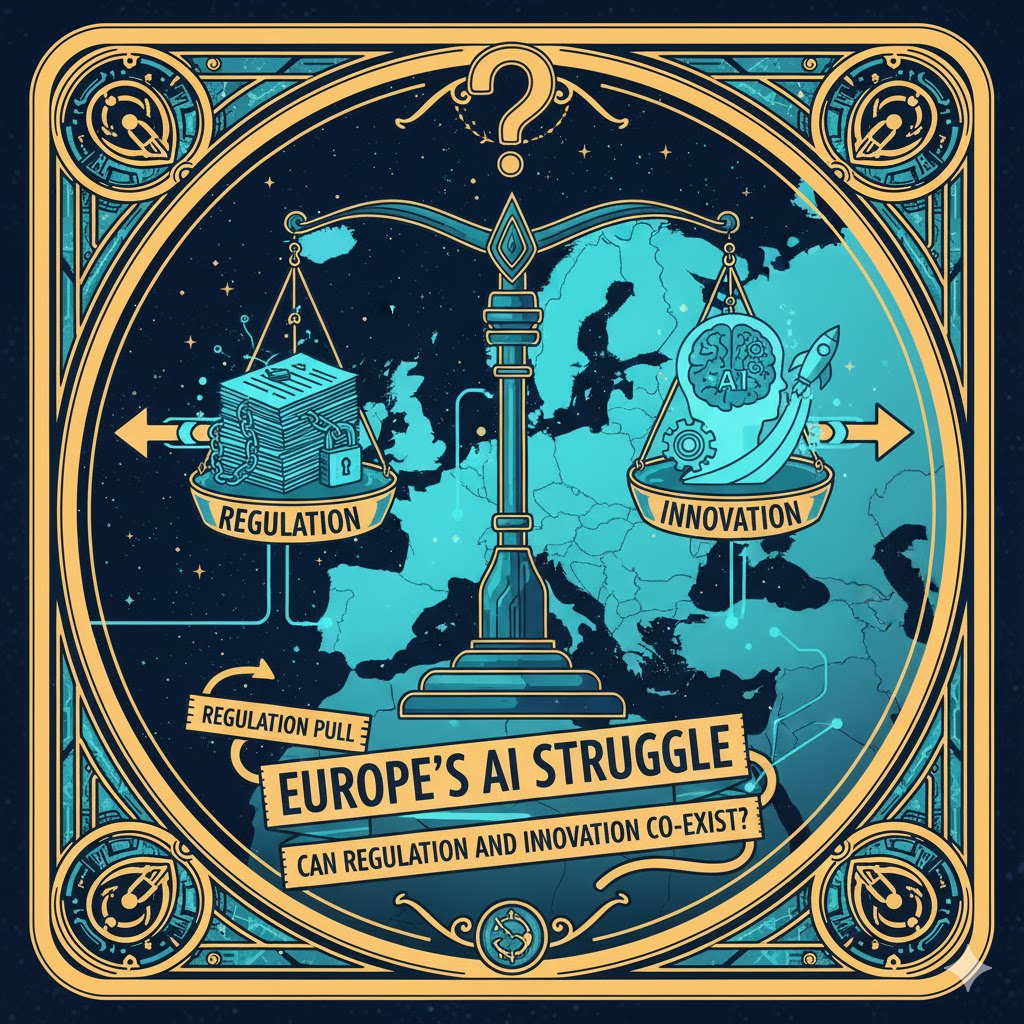Europe is determined to lead on tech ethics, yet its economy lags behind the United States and China in artificial intelligence (AI) and digital technology. As Brussels prepares to tweak the landmark AI Act and reduce red tape, many wonder whether Europe’s regulatory model risks sacrificing competitiveness. This article, adapted from a longer white paper, explores Europe’s AI investment gap, the dense web of rules that shape the digital market, and the structural barriers that lie beyond regulation. It then suggests how Europe can strike a balance between protecting citizens and fostering innovation.
Key Takeaways
- Europe invests far less in AI than its rivals. The EU accounted for about 7 % of global AI investment in 2021, whereas the United States captured 40 % and China 32 %europarl.europa.eu. U.S. institutions produced 40 notable AI models in 2024, China produced 15, and Europe only threehai.stanford.edu.
- Adoption of AI is limited. Over half of large European organisations have yet to scale AI, and just 13.5 % of EU enterprises use AI technologiesweforum.org.
- Regulation is deep and complex. The EU has around 100 tech‑focused laws governing data, competition and safetyecipe.org. New rules such as the AI Act, Digital Markets Act and Digital Services Act impose broad obligations and finesfortune.com. Industry critics say these layers of law create uncertainty and high compliance costsbroadbandbreakfast.com.
- Structural issues also matter. Europe’s venture capital markets are shallow; start‑ups rely on bank loans and face a fragmented market with de facto tariffs of 44 % for goods and 110 % for servicestheparliamentmagazine.eu. Only 55.6 % of Europeans have basic digital skillsdigital-strategy.ec.europa.eu.
- A new approach is brewing. Brussels is exploring a simplification package that would cut administrative burdens by at least 25 % for companies and delay parts of the AI Actfortune.com. But experts warn that simply pausing rules will not fix deeper design flawstheregreview.org.
Europe’s AI and Digital Gap
Europe’s ambition to become a “rule‑maker” in tech contrasts sharply with its performance. The Industry, Research and Energy committee of the European Parliament noted in 2025 that “weak investment and too much regulation are causing the EU to fall further behind on AI”europarl.europa.eu. Private investment figures illustrate the divide: U.S. firms poured $109 billion into AI in 2024—12 times more than China’s spending and far more than Europe’s contributionhai.stanford.edu. Not surprisingly, only three major European AI models emerged in 2024, all developed in Francehai.stanford.edu. Limited venture capital and risk‑averse banks make it hard for start‑ups to scalefuncas.es.
The adoption gap is equally stark. According to the World Economic Forum, 56 % of large European organisations had not scaled AI by mid‑2025, and only 13.5 % of EU enterprises used AI technologiesweforum.org. Many companies lack the GPU capacity and data infrastructure needed for AI workloadseuronews.com. Further, a mere 55.6 % of Europeans possess basic digital skillsdigital-strategy.ec.europa.eu, leaving millions unable to benefit from the digital revolution.
A Dense Web of Digital Laws
Europe’s regulatory landscape is vast and growing. A policy brief on digital competitiveness warns that roughly 100 tech‑focused laws regulate privacy, competition, cybersecurity and sector‑specific issues, thereby restricting digital usage and productivity growthecipe.org. The AI Act—the world’s first comprehensive AI regulation—classifies AI by risk and imposes strict requirements on “high‑risk” systems, with potential fines of up to 7 % of global revenue for non‑compliance. Alongside the AI Act sit the Digital Markets Act (DMA), which targets large online gatekeepers, and the Digital Services Act (DSA), which governs content moderation and platform duties.
These rules aim to protect citizens, yet the overlapping mandates create uncertainty. In late 2025, the European Commission proposed allowing a one‑year grace period for high‑risk AI providers and pushing transparency fines back to 2027fortune.com. The move followed pressure from U.S. officials and tech companies and reflected concerns that businesses needed more time to adapt. Meanwhile, the DMA’s interoperability requirements have slowed the rollout of certain products; Apple, for example, delayed releasing its AI‑enabled features in Europe due to compliance conflictsbroadbandbreakfast.com. Surveys show that 35 % of EU users find search results worse and 60 % require more clicks because of DMA‑mandated design changesbroadbandbreakfast.com.
Innovation on the Back Burner
Critics argue that Europe’s rights‑driven approach “regulates first and innovates second.” Entrepreneurs cite the challenge of navigating 27 different regulatory and tax regimes, which acts like a 110 % service tariff within Europetheparliamentmagazine.eu. Overlapping laws create administrative burdens, raise compliance costs and cause firms to focus on paperwork instead of product development. AI start‑ups raised only $12.5 billion in Europe in 2024 compared with $81.4 billion in the United Statesintereconomics.eu. Without easy access to venture capital, many promising companies migrate to the United States or Chinatheparliamentmagazine.eu.
The risk‑averse culture in Europe compounds the problem. Bankruptcy laws favour creditors and make failure costly, discouraging entrepreneurstheregreview.org. Visa policies are restrictive, and Europe has no unified scheme to attract skilled AI professionalstheparliamentmagazine.eu. Only 6 % of global AI startup funding flows to Europefuncas.es.
Factors Beyond Regulation
While rules are a big part of the story, they are not the sole reason for Europe’s lag. Fragmented markets, underdeveloped capital markets and underinvestment also play major roles. According to research, European digital markets have barriers equivalent to tariffs of 44 % for goods and 110 % for servicestheparliamentmagazine.eu, making cross‑border scale expensive. Venture funding lags because Europe lacks a robust capital markets union, forcing firms to rely on bank loansfuncas.es. Carnegie Europe notes that the EU’s recent shift toward deregulation may trade away safeguards without solving these underlying problemscarnegieendowment.org. A vibrant AI ecosystem requires a combination of investment, digital infrastructure, skills training and an open, unified market.
A Path Forward
To avoid being squeezed between the United States and China, Europe must embrace a dual strategy: uphold fundamental rights while empowering innovation. The following steps could help:
- Streamline and adapt regulation. Consolidate overlapping digital laws and ensure consistent implementation across member states. Build adaptive mechanisms—such as regulatory sandboxes, sunset clauses and real‑time monitoring—to keep regulations up to datetheregreview.org.
- Complete the Digital Single Market. Harmonise rules so that companies no longer face hidden tariffs. Finish the capital markets union to unlock venture capital and help start‑ups scaletheparliamentmagazine.eu. Simplification packages that reduce administrative burdens by 25 % for businesses and 35 % for SMEs are a startfortune.com.
- Invest in infrastructure and skills. Expand 5G/6G networks, cloud computing capacity and R&D funding. Provide citizens with digital training; the State of the Digital Decade report shows that only 55.6 % of Europeans have basic digital skillsdigital-strategy.ec.europa.eu.
- Foster a risk‑taking culture. Reform bankruptcy laws to encourage entrepreneurship and create a single EU visa for AI professionals. Support regulatory sandboxes where innovators can test AI systems safelytheregreview.org.
- Pursue open digital trade. Avoid unnecessary data localisation and protectionism. Encourage European firms to participate in global AI supply chains and adopt an open digital strategyecipe.org.
Conclusion
Europe’s ethical approach to technology has shaped global norms, but without adaptation, it risks becoming a digital backwater. Regulation can support innovation when it builds trust and provides legal certaintytheregreview.org. However, overlapping mandates, fragmented markets and weak investment have combined to stall Europe’s AI ecosystem. A dynamic, innovation‑friendly regulatory framework—paired with investment and unified markets—can help the continent protect its citizens while competing globally. The choice is not between ethics and innovation; it is about finding the right balance to ensure Europe remains relevant in the AI era.
Illustration: Europe’s Regulatory Burden
The following image symbolises how the weight of regulation slows Europe’s march toward innovation. A snail slowly carries a stack of law books across the continent—an apt metaphor for the current policy environment.










